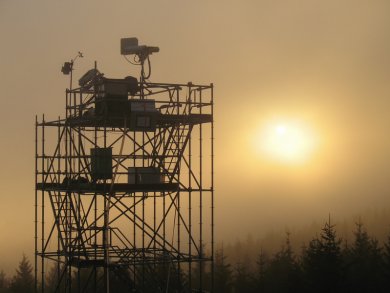Aerosol particles are, as condensation nuclei, an important trigger for the formation of clouds. As humidity accumulates on the particles, droplets are formed. They later develop into clouds. Within the clouds, the chemical composition of the aerosol particles changes. Eliza Harris and Bärbel Sinha, Max Planck Institute for Chemistry, Mainz, Germany, and colleagues investigated a cloud that formed on top of a mountain to find out exactly what happens.
Measurements with a NanoSIMS ion microprobe, a highly sensitive mass spectrometer, showed that sulfate in clouds forms mostly through the oxidation of sulfur dioxide by oxygen. This reaction is catalyzed by transition metal ions like iron, manganese, titanium, or chromium. The most important source of transition metal ions are large mineral dust particles. Sulfate production mostly occurred in cloud droplets which formed on such large mineral dust particles. Due to their size, they fall by force of gravity faster from the air. This reduces the time frame for climate cooling by sulfate particles which mainly involves the scattering of light, effectively increasing the Earth’s albedo or reflecting power.
Only one of twelve climate models considers the role of transition metal ions in the formation of sulfate. The others focus on alternative, less common pathways for sulfur dioxide oxidation by hydrogen peroxide, ozone, and the hydroxyl radical. Eliza Harris thinks that the impact on climate models of European regions might be low, as mineral dust concentrations in the air are small and sulfur dioxide emissions are declining. The effect of overestimating sulfate’s cooling effect could be stronger in India and China, where sulfur dioxide emissions are expected to rise in the near future, combined with significantly higher concentrations of mineral dust in the air.
Ground-based integrated study of chemical-aerosol-cloud interactions,
Schmücke Mountain, Thuringian Forest, Germany, September/October 2010.
© Dr. Stephan Mertes/TROPOS
- Enhanced role of transition metal ion catalysis during in-cloud oxidation of SO2,
Eliza Harris, Bärbel Sinha, Dominik van Pinxteren, Andreas Tilgner, Khanneh Wadinga Fomba, Johannes Schneider, Anja Roth, Thomas Gnauk, Benjamin Fahlbusch, Stephan Mertes, Taehyoung Lee, Jeffrey Collett, Stephen Foley, Stephan Borrmann, Peter Hoppe, Hartmut Herrmann,
Science 2013.
DOI: 10.1126/science.1230911




